
Salamanca is a province of western Spain, in the western part of the autonomous community of Castile and León. It is bordered by the provinces of Zamora, Valladolid, Ávila, and Cáceres, and on the west by Portugal. It has an area of 12,349 km2 and in 2018 had a population of 331,473 people. It is divided into 362 municipalities, 11 comarcas, 32 mancomunidades and five judicial districts. Of the 362 municipalities, more than half are villages with fewer than 300 people.
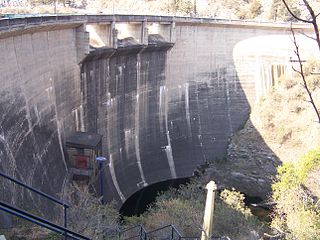
The Los Molinos Dam is a dam over the course of the Los Molinos River in the center-west of the province of Córdoba, Argentina, about 769 metres (2,523 ft) above mean sea level.
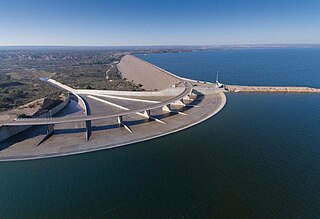
The El Carrizal Dam is a dam on the upper-middle course of the Tunuyán River, in the center-north of the province of Mendoza, Argentina upstream from the city of Rivadavia. Its reservoir measures about 15 by 5 kilometres, and its maximum water level stands at 785.5 metres (2,577 ft) above the sea, covering an area of 34.8 square kilometres (13.4 sq mi). It has a maximum volume of 462 million cubic metres.

The Arroyito Dam is the fifth of five dams on the Limay River in northwestern Argentine Patagonia, at 315 metres (1,033 ft) above mean sea level. It was inaugurated in 1979.
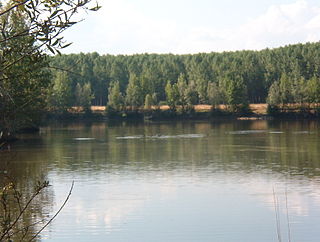
The Esla is a river in the provinces of León and Zamora in the northwest of Spain. It is a tributary of the Duero River that starts in the Cantabrian Mountains and is 275 kilometres (171 mi) long. Its direction of flow is from north to south. It is the largest tributary of the Duero in terms of discharge; in fact, at its mouth at the confluence with the Duero, it has a greater discharge than the volume in the main river.

The Aldeadávila Dam is a Spanish concrete arch-gravity dam, straddling the border between Spain and Portugal on the Duero River. The nearest town is Aldeadávila de la Ribera in the Province of Salamanca, about 11.3 kilometres (7.0 mi) to the east. The nearest Portuguese town is Fornos in Bragança District, about 8 kilometres (5.0 mi) to the southwest. The Portuguese side of the river around the dam site lies within the Arribes del Duero Natural Park.

La Esmeralda Dam is an embankment dam on the Batá River northwest of Santa María in Boyacá Department, Neira Province, Valle de Tenza Colombia, 52 km to south of Tunja city. The primary purpose of the dam is hydroelectric power production and it is part of the Chivor Hydroelectric Project. Water from the Batá is diverted by the dam to a power station that discharges to the Lengupá River. The power station supplies 8% of Colombia's power demand.
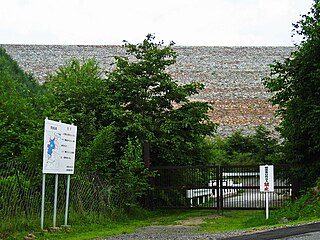
The Kazunogawa Pumped Storage Power Station is a pumped-storage hydroelectric power station near Kōshū in Yamanashi Prefecture, Japan. The station is designed to have an installed capacity of 1,600 megawatts (2,100,000 hp) and three of the four 400 megawatts (540,000 hp) generators are currently operational, for a total operational capacity of 1200 MW. Construction on the power station began in 1993 and the first generator was commissioned on 3 December 1999. The second was commissioned on 8 June 2000. The third one became operational on 9 June 2014, six year early due to post-power demand from the Great East Japan earthquake. The fourth and final generator is slated to be commissioned by 2024. It is owned by TEPCO and was constructed at a cost of US$2.2 billion.

The Allal al Fassi Dam is an embankment dam located 18 kilometres (11 mi) northeast of Sefrou on the Sebou River in the Fès-Meknès region of Morocco. Completed in 1991, it provides water for irrigation and hydroelectric power production. The dam was named after the famous Moroccan Allal al-Fassi.
The Monción Dam is an earth-fill embankment dam on the Mao River near Monción in Santiago Rodríguez Province of the Dominican Republic. At 119 m (390 ft) tall, it is the highest dam in the country and the Caribbean. The purpose of the dam is to produce hydroelectric power and supply water for irrigation. The dam's power station is located downstream and contains two 26 MW Francis turbine-generators for an installed capacity of 52 MW. The dam was completed and began filling its reservoir on 22 September 2001. Its power station was commissioned on 27 April 2002.
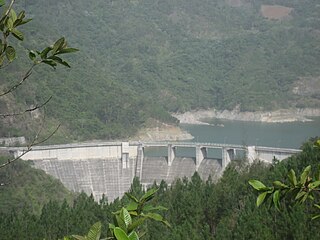
The Jigüey Dam is an arch-gravity dam on the Nizao River about 32 km (20 mi) west of San Cristóbal in San José de Ocoa Province of the Dominican Republic. At 110.5 m (363 ft) tall, it is the third highest dam in the country. The purpose of the dam is to produce hydroelectric power and it supplies the largest hydroelectric power station in the country.
The Hatillo Dam is an earth and rock-filled embankment dam on the Yuna River about 6 km (3.7 mi) southwest of Cotuí in Sánchez Ramírez Province of the Dominican Republic. With a storage capacity of 710,000,000 m3 (580,000 acre⋅ft), the dam's reservoir is the largest in the country. The purpose of the dam is to produce hydroelectric power, provide water for irrigation and to control floods. The power station is located at the base of the dam and contains a single 8 MW Francis turbine-generator. Construction on the dam began in August 1977 and it was completed in 1984.

The Alarcón Dam is a gravity dam on the upper course of the Júcar River. It is located 6 kilometres (3.7 mi) from Alarcón, in the province of Cuenca, in the autonomous community of Castilla-La Mancha, Spain.

El Salto Dam, located on the Guadalquivir River in the municipal district of El Carpio, comprises a dam and its corresponding hydroelectric power station.

Santillana reservoir, also known as Manzanares el Real reservoir, is a body of water along the Manzanares river located in the municipalities of Manzanares el Real and Soto del Real, in the Community of Madrid, in the centre of Spain. It has a maximum surface of 1052 ha, the longest distance between opposites shores reaches 30 kilometres (19 mi), and the total volume of the reservoir is 91 hm³. The first dam was built in 1907, but in 1969 a new and higher dam was built. This new construction was 5 m higher, which allowed the reservoir to have a volume twice as large as before.

Bolarque Dam is a concrete gravity dam on the Tagus in Spain, where the river forms the border between the provinces of Cuenca and Guadalajara. About 6 km downstream from the dam is the José Cabrera Nuclear Power Station.

Mequinenza Dam is a concrete gravity dam in the province of Zaragoza, Spain. It impounds the Ebro creating a large reservoir, which is called Mar de Aragón. About 35 km downstream of Mequinenza dam is Ribarroja dam.
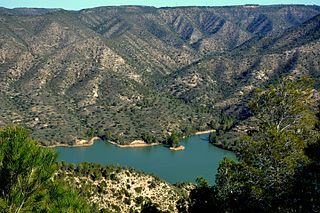
Ribarroja Dam is a concrete gravity dam located in the province of Tarragona, Spain, that impounds the Ebro. About 35 km upstream of Ribarroja dam is Mequinenza dam. About 15 km downstream is Flix dam.

Ricobayo is a locality in the province of Zamora, Spain. Formerly a municipality in its own right, it is part of Muelas del Pan.
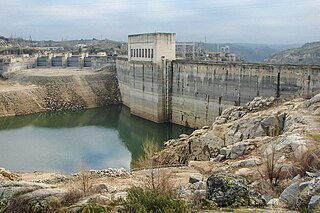
The Ricobayo Dam is a hydroelectric engineering work built on the lower course of the Esla river. It is located less than 1 km from Ricobayo de Alba, in the province of Zamora, Castilla y León, Spain.






















